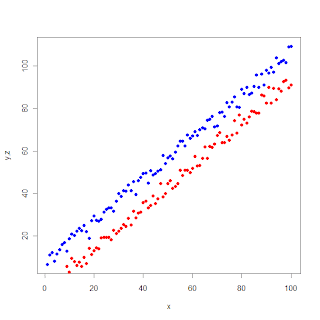PRECIP EVAPOTRANS GR.WAT.FLOW RUNOFF STREAMFLOW -----------------(cm)---------------------------------- Apr 3.3 2.2 1.5 0.0 1.5 May 4.9 7.2 0.8 0.0 0.8 June 13.2 11.3 0.0 0.1 0.2 July 12.5 11.5 0.4 0.5 0.9 Aug 6.4 9.8 0.0 0.0 0.0 Sept 7.9 7.2 0.0 0.0 0.0 Oct 3.6 4.5 0.0 0.0 0.0 Nov 6.7 1.0 0.0 0.0 0.0 Dec 7.6 0.5 4.1 0.3 4.4 Jan 4.0 0.2 5.6 0.2 5.8 Feb 9.4 0.2 3.8 1.0 4.8 Mar 6.9 0.7 9.7 1.5 11.2 --------------------------------------------------------------- YEAR 86.4 56.4 26.0 3.6 29.6 Lets create function to obtain annual and monthly sums
About the Blog
Contributors
Archieves
Labels
- Basic (7)
- CRD (1)
- data access (1)
- data creation (1)
- data steps (3)
- gl (1)
- Introduction (5)
- packages (3)
- R (8)
- read.fwf (1)
- read.table (1)
- rep (1)
- scan (1)
- seq (1)
- sequence (1)
- xlsRedWrite (1)
Thursday, October 29, 2009
Multiple variables in the same scatter plot

legend(10,85,legend = c("y","z"), col = c("blue", "red"),pch = 16)
# here 10, and 85 are the xy-coordinates where the legend-box will be added on the graph.
Now the graph is complete.
Saturday, February 21, 2009
Article about R in NYTimes
I was just browsing the net and found an interesting and very good article in NYtimes.
I am touched by the first sentence. R could be just 18th letter of English alphabet ………………., that’s exactly what happened many times when I mentioned R in some friends circle.
Wednesday, February 11, 2009
Data accessing, editing and Manipulation
lets create some vectors,
1: Var1<-c(1,2,3,1,2,4,5,0,2,6,8,5,3,7,5,2,8,9,2,10) 2: Var2<-rep(c(1,2,3,4) each=5) 3: Var3<-rep(1:5, 4)now, lets make a data frame
1: > datalist<-data.frame(Var1, Var2, Var3)
Var1 Var2 Var3
1 1 1 1
2 2 1 2
3 3 1 3
4 1 1 4
5 2 1 5
6 4 2 1
7 5 2 2
8 0 2 3
9 2 2 4
10 6 2 5
11 8 3 1
12 5 3 2
13 3 3 3
14 7 3 4
15 5 3 5
16 2 4 1
17 8 4 2
18 9 4 3
19 2 4 4
20 10 4 5
so, the variable names can be changed now with,
> names(datalist)<-c("X", "Y", "Z")
Data Access:
> datalist[1:4,]
X Y Z
1 1 1 1
2 2 1 2
3 3 1 3
4 1 1 4
> datalist[1:3,1:3]
X Y Z
1 1 1 1
2 2 1 2
3 3 1 3
> datalist[3,3]
[1] 3
> datalist$X[c(2,5,8)]
[1] 2 2 0
> datalist$X[-c(2,5,8)]
[1] 1 3 1 4 5 2 6 8 5 3 7 5 2 8 9 2 10
> datalist[c(2,5,8),c(1,2)]
X Y
2 2 1
5 2 1
8 0 2
Note that, X variable can not be accessed directly and we used datalist$X , if we want to access X directly we can use attach() function
> X
Error: object "X" not found
> attach(datalist)
> X
[1] 1 2 3 1 2 4 5 0 2 6 8 5 3 7 5 2 8 9 2 10
Tuesday, February 10, 2009
Generating treatment maps for a typical CRD experiment
Hellooo!
Saturday, February 7, 2009


